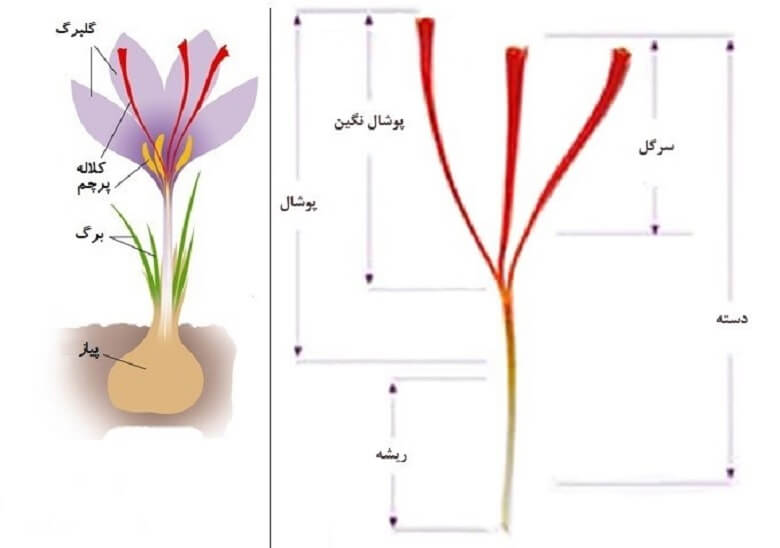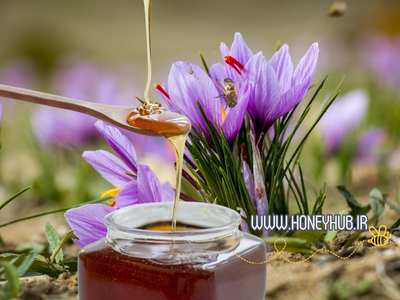Does your mozzarella refuse to stretch or just burn? The secret is science. From "pasta filata" to the crucial role...
Healing Benefits of Saffron Honey: A Rare Natural Treasure
Properties of Saffron Healing Honey: A Treasure of Nature
Introduction to Saffron Healing Honey
Among the various types of natural honey, long celebrated as one of nature’s finest gifts, saffron healing honey holds a special place. Produced by honeybees from the nectar of saffron flowers, this rare and exceptional honey not only delights the palate with its exquisite flavor but also brings a wealth of medicinal and therapeutic benefits. Unlike ordinary honey or artificial blends made by adding saffron to honey, natural saffron honey is the result of a complex and unique natural process that occurs only under specific conditions.
Known as "red gold," saffron is a plant of high economic and medicinal value, primarily recognized for its red stigmas. However, the plant’s purple flowers also play a vital role in the production of saffron honey. In this comprehensive article, we will explore the detailed process of producing this honey, its differences from similar products, its numerous benefits, and the reasons behind its rarity and value. If you’re eager to gain a deeper understanding of this natural treasure, stay with us until the end.
Characteristics of the Saffron Plant
Saffron is a small perennial plant growing to a height of 10 to 30 centimeters. From the center of its bulb or stem base, several narrow, elongated leaves emerge. A flowering stem rises from among the leaves, bearing one to three flowers. These flowers feature six purple petals, which in some varieties may appear pink or violet. Each flower contains three stamens and a pistil leading to a three-branched stigma that ranges from red to orange in color. The part of the plant used—known as saffron—is the stigma and the end of the style, which is aromatic and slightly bitter.

The Process of Saffron Honey Production by Honeybees
The production of saffron honey is a natural process that relies on precise cooperation between honeybees and saffron flowers. Saffron (Crocus sativus) is cultivated in specific regions of the world, such as Iran, Spain, Greece, and Kashmir. This plant blooms in the fall, typically from late October to early November. The bright purple saffron flowers produce a sweet, aromatic nectar that bees feed on.
What makes this process unique and challenging is the short blooming window of saffron. Unlike many plants that flower and produce nectar for months, saffron blooms for only two to three weeks each year. This tight timeframe means beekeepers must relocate their hives to saffron fields at just the right moment to allow the bees to take advantage of this brief opportunity. If the timing isn’t perfect, the chance to produce saffron honey is lost.
After collecting nectar from saffron flowers, bees transport it to the hive. Inside the hive, the nectar undergoes a biochemical transformation facilitated by enzymes in the bees’ bodies. This process reduces the nectar’s moisture content and breaks down complex sugars into simpler ones, ultimately resulting in honey. The saffron honey produced has a golden-orange hue and a mild, complex flavor that blends the sweetness of honey with the aroma of saffron.
To produce this honey, beekeepers need significant experience and knowledge. They must ensure the hives are healthy, regulate the bee population, and protect the fields from chemical contamination to keep the honey organic and pure. This precision and effort elevate saffron honey beyond a mere food item—it becomes a natural work of art.
Note: Due to its limited production, some uninformed individuals deny the existence of this valuable honey.
Differences Between Natural Saffron Honey and Honey-Saffron Mixtures
In artificial mixtures, producers typically add dried saffron or its extract to regular honey to impart saffron’s color, flavor, and aroma. This method is simple and quick, requiring no natural production process by bees. However, the result is a product that only superficially carries some of saffron’s properties and lacks the natural balance of compounds found in genuine saffron honey.
For example, active compounds in saffron, such as crocin, crocetin, and safranal, are present in natural saffron honey in a balanced, bioavailable form. In artificial mixtures, these compounds may not fully dissolve or could be degraded by heat or manual processing. Additionally, natural saffron honey offers a smoother flavor and a lasting aroma, while artificial blends may have a sharp, unnatural taste that fades quickly.
Healing Properties of Saffron Honey
Thanks to the unique combination of saffron flower nectar and the natural production process by bees, saffron honey boasts exceptional therapeutic and nutritional properties. Saffron itself is one of the world’s most potent medicinal plants, and when paired with the benefits of natural honey, it creates a product that nourishes both body and soul. Below are some of its most significant benefits:
- Boosting the Immune System: Saffron honey is rich in antioxidants like crocin and safranal, which combat free radicals. These compounds strengthen the immune system, making the body more resistant to infections and diseases.
- Improving Mental Health and Reducing Stress: Saffron has long been known as an antidepressant. Studies show that safranal and crocin in saffron can increase serotonin levels in the brain, helping to reduce anxiety and depression. Saffron honey inherits this property, and regular consumption can promote mental calm and improve mood.
- Enhancing Libido: Due to active compounds like crocin and safranal, saffron honey is recognized as a natural aphrodisiac. This benefit is particularly effective for men, as these compounds improve blood circulation and energy levels, enhancing sexual performance and supporting hormonal balance. Saffron has been used in traditional medicine for centuries to boost libido, a trait well-preserved in saffron honey.
- Anti-Inflammatory and Pain Relief: The anti-inflammatory compounds in this honey can help reduce chronic inflammation in the body, such as arthritis or digestive issues. This is especially beneficial for those suffering from joint pain.
- Supporting Heart and Vascular Health: The antioxidants in saffron honey help lower bad cholesterol (LDL) and improve blood circulation. This can reduce the risk of heart disease and support long-term cardiovascular health.
- Improving Digestion: Like other honeys, saffron honey has antibacterial properties that can aid in treating stomach issues such as ulcers or bloating. It also supports better digestion and regulates metabolism.
- Enhancing Vision: Crocin in saffron improves blood flow to the retina, potentially preventing conditions like macular degeneration. Saffron honey reinforces this benefit, contributing to eye health.
- Anti-Aging Properties: The antioxidants in this honey protect against cellular damage and slow skin aging. Regular consumption or topical use can promote youthful, radiant skin.
These benefits are just a glimpse of saffron honey’s advantages. Researchers continue to explore its various aspects, uncovering new insights into its positive effects on health daily. For instance, preliminary studies suggest it may help regulate blood sugar and improve sleep, though further research is needed.
Saffron Honey – A Unique Taste from Nature! 🍯

✨ A Fusion of Saffron Aroma & Natural Sweetness ✨
Indulge in the exquisite taste of Saffron Honey! 🍯🌸 A gift from nature that brings energy and tranquility to your day. 👇
Why Is Saffron Honey Rare and Valuable?
The second factor is the geographical limitation of saffron cultivation. This plant thrives in specific climates and grows well only in regions like Iran (the world’s largest saffron producer), Spain, Kashmir, and parts of Greece. This means beekeepers elsewhere lack access to this resource, restricting saffron honey production to these areas.
Finally, high demand and low supply further increase its value. Due to its exceptional properties and unique flavor, saffron honey is highly sought after in international markets, yet its limited production often makes it a luxury, high-priced product. For example, even in Iran, where both saffron and honey are abundant, saffron honey production remains small-scale, with many beekeepers preferring to focus on more common honey varieties.
Uses of Saffron Honey in Daily Life
Saffron honey can be incorporated into daily life in various ways. The simplest method is consuming it raw—a teaspoon in the morning can provide energy and boost your immune system. You can also mix it with warm water for a soothing drink.
In cooking, saffron honey serves as a natural sweetener for desserts, tea, or even traditional dishes like Persian sholeh zard. Its mild flavor and delightful aroma add depth and appeal to recipes. Some also use it topically as a face mask to benefit from its anti-aging and skin-brightening properties.
In traditional medicine, saffron honey is often recommended for colds, insomnia, and skin issues. Combining it with other herbs like cinnamon or ginger can amplify its therapeutic effects.
Conclusion
Saffron healing honey is a natural masterpiece born from the collaboration of honeybees and saffron flowers. It offers not only an unparalleled taste and aroma but also remarkable medicinal and nutritional benefits. The short saffron blooming period, intricate production process, and geographic limitations make this honey one of the rarest and most valuable natural products.
Unlike artificial honey-saffron blends, natural saffron honey is crafted within the hive and contains compounds that enhance both physical and mental well-being. From boosting immunity to improving heart health and reducing stress, this honey can play a vital role as a natural supplement in your daily life. If you’re seeking a unique and healthy experience, saffron honey is an option that satisfies your taste buds while supporting your health.
Leave a comment
Log in to post comments
Related posts
 Propolis: A natural substance with multiple medicinal and therapeutic properties
Propolis: A natural substance with multiple medicinal and therapeutic properties Amazing Benefits of Linden Honey: The Calming Nectar of the Forest
Amazing Benefits of Linden Honey: The Calming Nectar of the Forest



















Latest comments